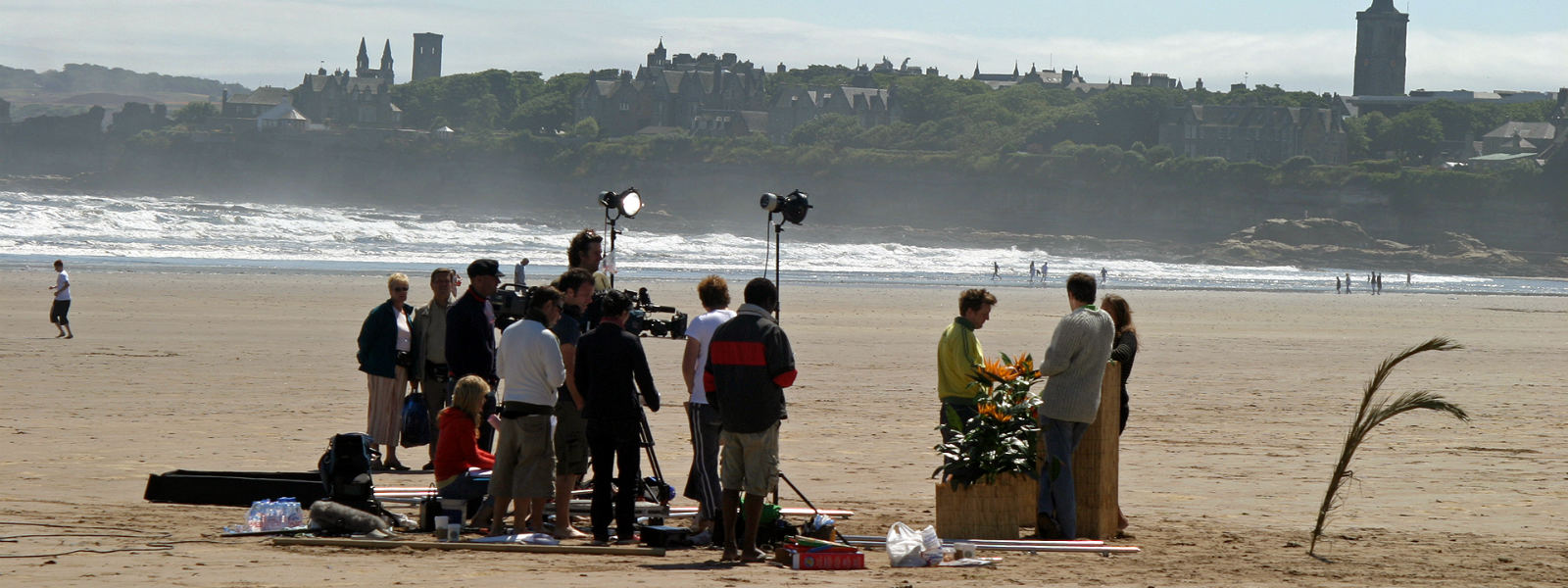Breakthrough for UK movie industry as real-time scenes shot 280 miles apart
- Rapid 5G internet connection links Virtual Production ‘movie magic’ screens for simultaneous shoot with actors located in both Dundee and Manchester
- Industry partners team up with universities on pathfinder project to deliver ‘climate-friendly’ approach for TV, film and performing arts.
The first scenes from a ground-breaking movie making project have today been released, showcasing a new Virtual Production technique that allows actors to work together in real-time in two different locations using a 5G internet connection.
In a first for the UK film industry, the test sequence used the rapid bandwidth speed of wireless 5G to connect industry quality digital backdrop screens in studios in Dundee and Manchester, allowing two actors to be filmed against a consistent virtual environment, without the need to travel to an exotic location, or be in the same room.
Virtual Production is a new cinematography technique that uses computer-generated imagery (CGI), high-definition LED screens and motion capture to create virtual sets, allowing filmmakers and theatre directors to create large-scale digitally generated environments to support real-time interaction, offering a faster, less expensive alternative to green screens.
The project is the first UK proof of concept for wireless virtual production film-making, opening the door to a more flexible approach as 5G is rolled out across the country, while also showcasing the potential for mobile studios capable of being set up on any site with a 5G connection.
Led by Abertay University in Dundee, the 5G project is part of the Tay5G use case trial funded by the Scottish and UK Governments through the Tay Cities Region Deal and is supported and delivered by Space Digital, Dundee City Council; InGAME (Innovation for Games and Media Enterprise); VSS (Video Screen Services), StoryFutures; Royal Holloway, University of London; Scotland 5G Centre and telecoms infrastructure company AWTG.
A large LED screen, part of which was previously used to film 2022 movie The Batman, was installed by VSS in Abertay’s new Virtual Production Research Environment in Dundee and was linked via 5G by AWTG to a similar screen in Manchester.
The short test sequence – featuring a sci-fi narrative based around AI Armageddon - was directed by Professor Peter Richardson, Head of Virtual Production at StoryFutures and Professor of Creative Industries at Royal Holloway, University of London.
He said: “From a directing perspective, we had a team up in Dundee and a team down in Manchester where I was physically based, and I would give the actors direction over the 5G network, as well as receiving a direct feed from the camera in Dundee. I could see both shots on my monitor and the two actors that are 280 miles away acting together as though they were there in the same room. It’s been an interesting journey and we managed to get some really great material, so when the shots are compiled together you really do believe the actors are side by side, face to face.”
Abertay University hosts the 5G testbed in Dundee, giving researchers access to a private, controlled network to develop high-performing mobile processes almost matching the speeds of hard-wired connections.
Matt Bett of Abertay University’s Division of Games Technology and Mathematics said the use of virtual production coupled with 5G has enormous potential for the industry, including scope for a significant reduction in carbon footprint through reduced travel.
He added: “The Tay5G Virtual Production project has given us an opportunity to showcase the power of 5G for film production in a way that's never been accomplished before. These results open the way for 5G to facilitate some major advances in the film and TV industries in the future and to put the UK at the forefront of the huge range of possibilities currently the horizon.”
The Tay5G project is funding a range of use case trials using 5G mobile technology in the Tay Cities Region, building on the area’s strategic strengths in the creative and digital industries. The core partnership consists of the Councils of Dundee City, Angus, Fife and Perth & Kinross.
Scottish Government Innovation Minister Richard Lochhead said: “I congratulate Abertay University and partners on developing this transformative new approach to film making.
“Scottish Government funding through the Tay Cities Region Deal is helping place Dundee in the vanguard by supporting cutting edge technology, promising to significantly reduce the film industry’s carbon footprint while helping the regional economy grasp enormous opportunities enabled by 5G.”
Dundee’s Fair Work, Economic Growth and Infrastructure Convener, Councillor Steven Rome said: “It is incredibly exciting to see Dundee at the forefront of this groundbreaking work and use of 5G. When the Tay5G project was being developed, we knew that Virtual Production offered huge potential to build on the partners’ expertise across production and games as well as the outcomes from transnational EU project Create Converge and creative clusters InGAME and Story Futures. With the recent announcement of a new ‘movie magic’ research lab planned for Dundee, we’re building on world-class expertise in the creative and tech sectors to deliver our shared vision for a strong, smart and sustainable local economy with jobs and opportunities for all.”



